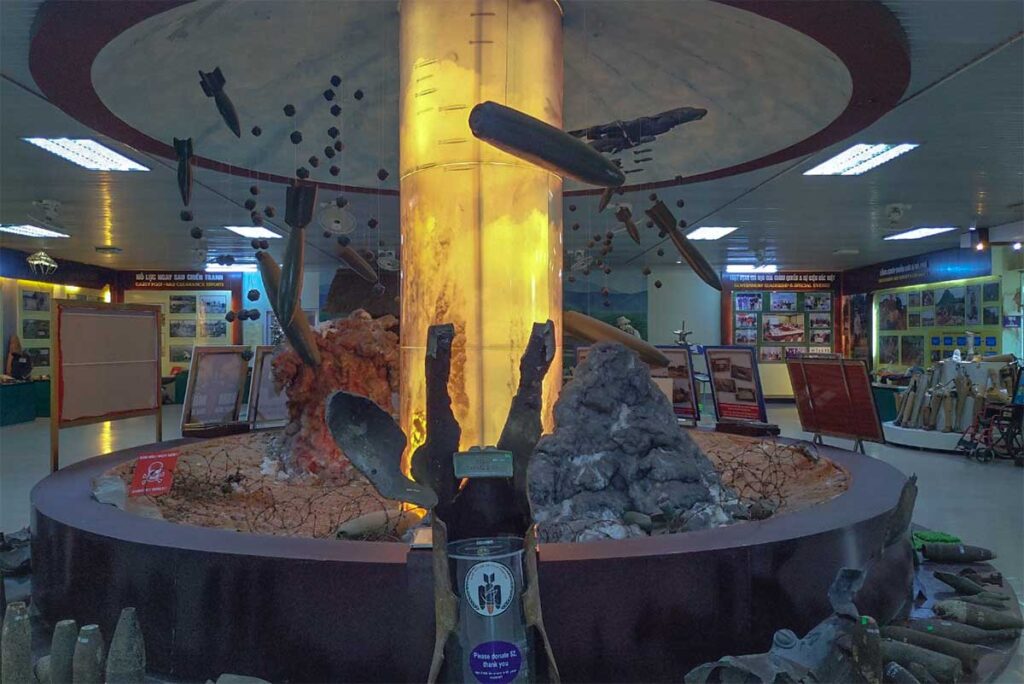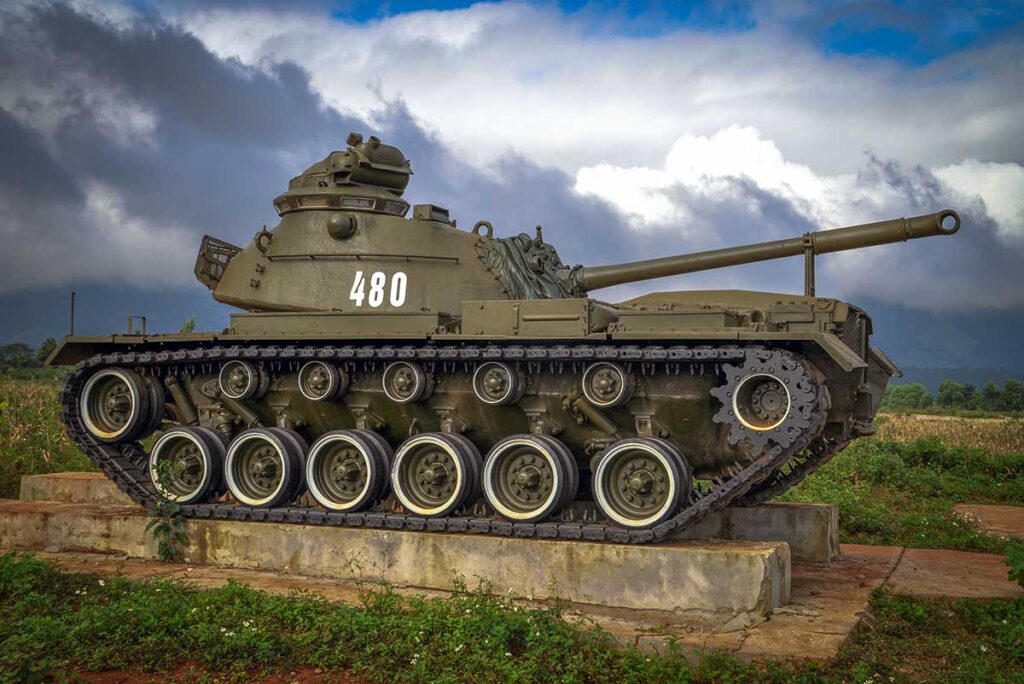What is the Mine Action Visitor Center about?
The Mine Action Visitor Center is a small museum in Dong Ha, the provincial capital of Quang Tri. Its focus is not on military victories or battlefield tactics, but on the human cost of war and the danger that unexploded bombs still pose today. Exhibits explain how clearance teams continue to remove ordnance, how victims receive support, and how communities are educated to stay safe.
The center is part of Project RENEW, a cooperation between local authorities and international NGOs that has been clearing land and supporting victims in Quang Tri for more than two decades. While details of the project’s work come later in this guide, the museum gives a straightforward introduction to these efforts. It’s a compact stop, but it provides useful context before exploring other DMZ sites.
The history and aftermath of the Vietnam War
The Vietnam War in brief
The Vietnam War (1955–1975) was one of the most devastating conflicts of the 20th century, involving North Vietnam and its allies against South Vietnam, backed by the United States and others. What began as a civil conflict escalated into a massive international war, with intense bombing campaigns, ground battles, and huge civilian losses. By the time the war ended in 1975, millions of Vietnamese had been killed or injured, cities and farmland were destroyed, and unexploded ordnance remained scattered across the country.
The DMZ in Quang Tri
Quang Tri Province was divided by the Demilitarized Zone (DMZ), a narrow strip of land around the 17th parallel that marked the border between North and South Vietnam. Instead of being a neutral buffer, the DMZ became one of the most heavily bombed areas of the entire war. Quang Tri City and its historic citadel were almost completely destroyed during battles in 1972. Villages were abandoned, farmland was cratered, and the province endured relentless bombing runs, leaving behind one of the highest concentrations of unexploded bombs in the world.
The Aftermath
The war’s end did not mean safety for the people of Quang Tri. An estimated 15 million tons of bombs were dropped on Vietnam, and many failed to detonate. Even decades later, unexploded ordnance (UXO) continues to injure or kill farmers, children, and scrap metal collectors. In addition to bombs and mines, the chemical defoliant Agent Orange left generations of people suffering from birth defects and chronic illnesses. Since 1975, over 8,000 people in Quang Tri alone have died due to accidents with UXO, and tens of thousands more live with lifelong disabilities.
Why a Mine Action Center?
With so much of Quang Tri’s land contaminated, clearance is essential for daily life. Farmers cannot safely work their fields, children risk encountering explosives, and communities struggle to rebuild without safe land. The Mine Action Visitor Center was created to explain this reality to visitors and to highlight the ongoing efforts of local teams and international partners. It serves not only as a museum, but also as an educational tool to raise awareness of the dangers that remain and the progress being made to make the province safe.
What to see at the Mine Action Visitor Center
The Mine Action Visitor Center is not a large museum — in fact, it mostly fits into a single exhibition hall — but it manages to cover a lot of ground. The displays are simple yet powerful, and what makes the visit especially meaningful is often the staff who take the time to explain the stories behind them. Here’s what you can expect inside.
1. Exhibits on War and UXO
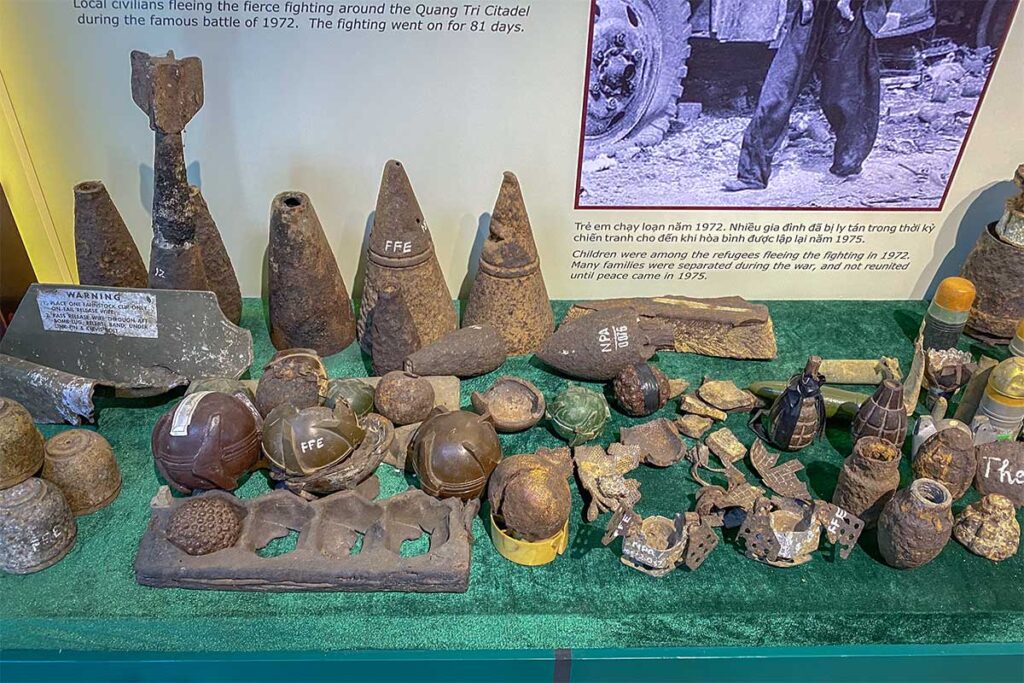
The first displays focus on the Vietnam War and its legacy in Quang Tri. Photographs show the destruction of the province, including the ruins of Quang Tri Citadel, alongside images of local people trying to disarm bombs with little more than bamboo sticks. Lifelike models of munitions and real pieces of unexploded ordnance (UXO) illustrate the types of weapons that still turn up in fields and villages today.
2. Clearance & Education
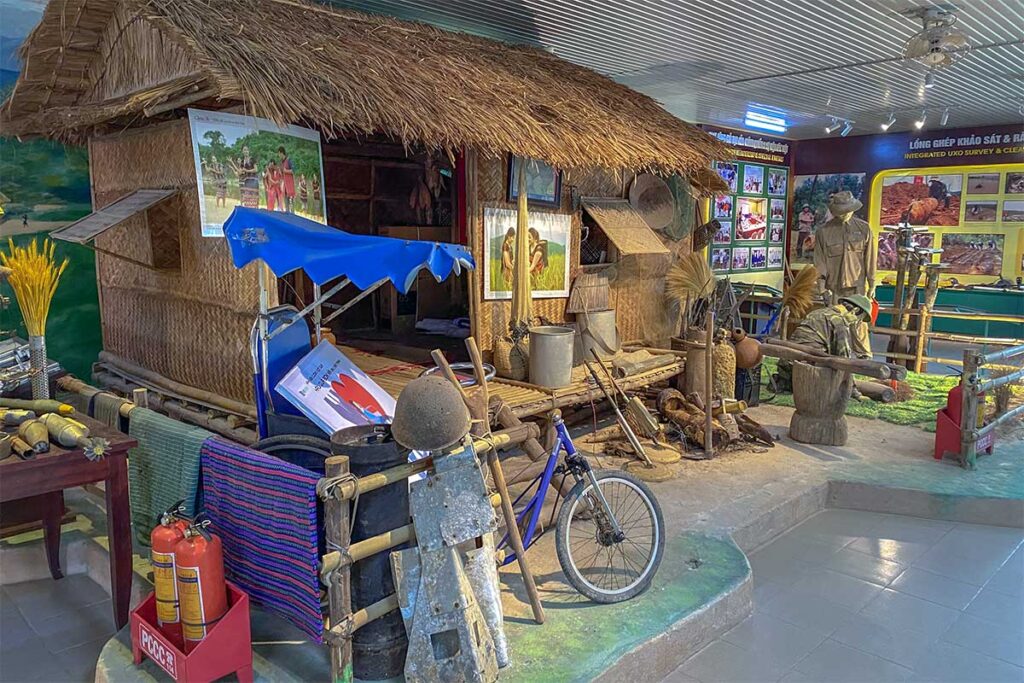
Panels and maps explain how much of Quang Tri remains contaminated and how clearance teams identify and remove explosives. You’ll see how international NGOs and local staff work together, and there are sections dedicated to risk education programs that teach children what to do if they encounter ordnance. The large maps showing confirmed hazardous areas are particularly striking, giving a sense of just how widespread the problem still is.
3. Victim assistance
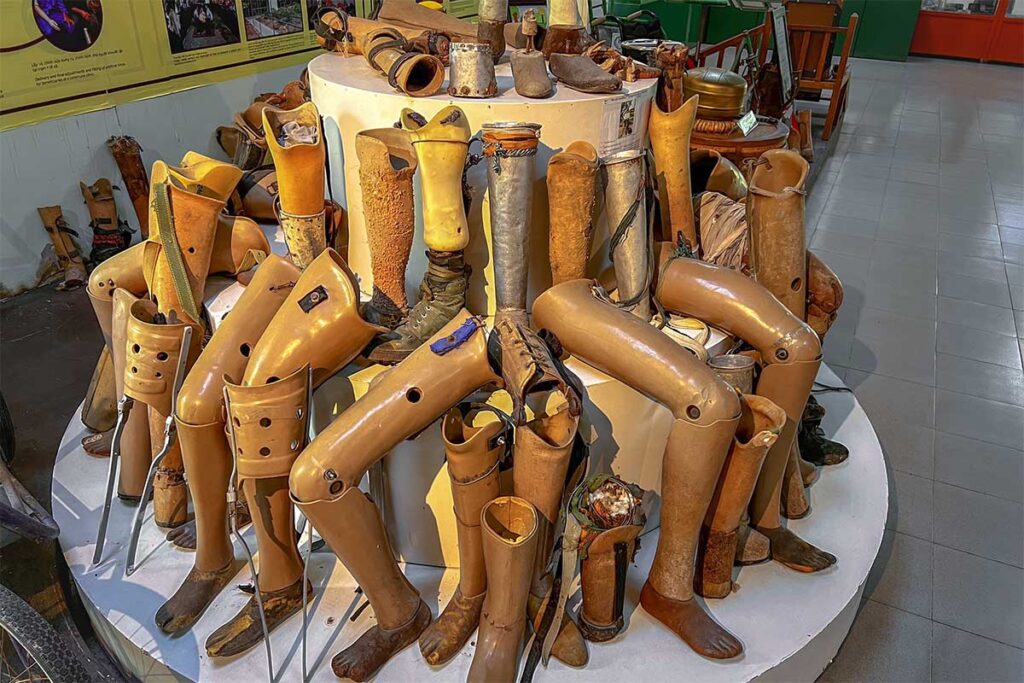
One of the most moving sections covers victim assistance. Exhibits include homemade prosthetic limbs once used by survivors, as well as modern prosthetic and orthotic devices provided through rehabilitation programs. Drawings made by children warn against playing with bombs or mines — a simple but haunting reminder of how young people are still affected. Personal stories of survivors add a human side to the statistics.
4. Films and Media Theater
A small theater shows documentaries ranging from short clips of about ten minutes to longer features of an hour or more. These films use archival footage and interviews to explain both the war’s devastation and the ongoing clearance work. If you have the time, it’s worth sitting down for at least one film to get a fuller picture.
5. Everyday Stories & Hope
The center doesn’t only focus on tragedy — it also highlights resilience. A section called “Victory over Tragedy” shares stories of ordinary people who have rebuilt their lives despite injury or loss. These exhibits show how education, community support, and sheer determination have helped families find ways to move forward.
6. Facilities
For a small museum, the visitor facilities are surprisingly good. There’s a café serving drinks and light snacks, a souvenir booth with books and local handicrafts, and clean restrooms with disability access. Free Wi-Fi and desktop computers are also available, which can be handy for travelers. The staff are known for being welcoming and happy to answer questions, making the visit more personal than at larger museums.
Practical visiting information
Location and Address
The Mine Action Visitor Center is located in Dong Ha, the capital of Quang Tri Province. Dong Ha is a small, quiet town with limited tourist infrastructure, about two hours by car from Hue. Most visitors come here as part of a DMZ tour rather than making a special trip, though you can also reach it by train or bus from Hue or Dong Hoi and then take a taxi across town.
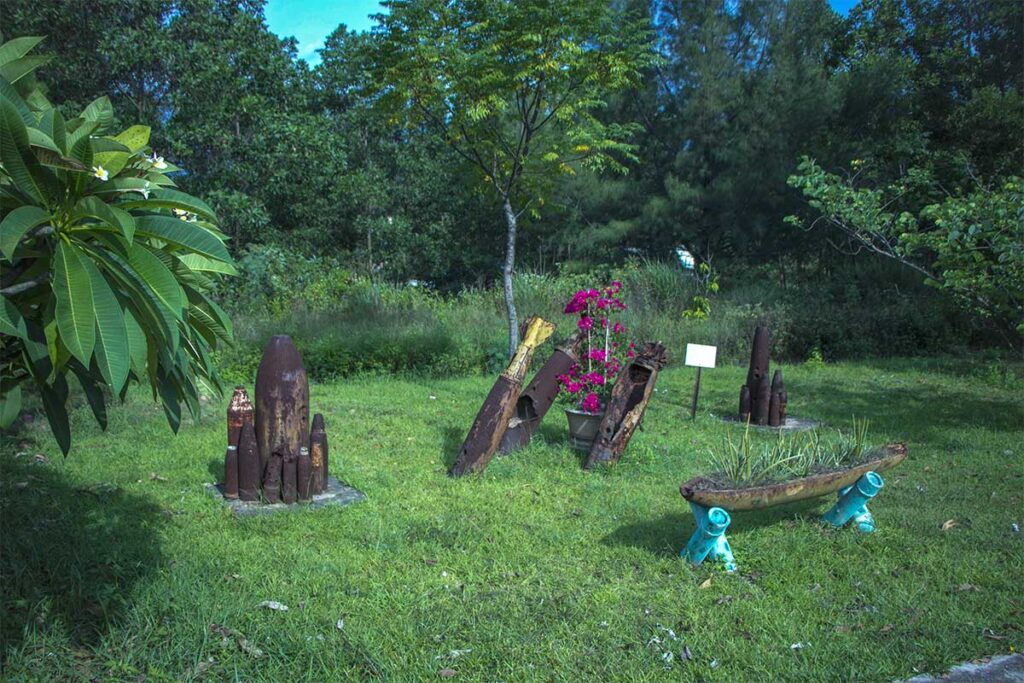
Opening times
The center is open Monday to Friday from 08:00 to 17:00. It is usually closed on weekends unless you contact the staff in advance to arrange a visit. Because the museum isn’t heavily visited, it’s wise to double-check availability before making the journey.
Entrance Fee
There is no fixed entrance fee, but a voluntary donation of around $2 USD is encouraged. Donations go toward maintaining the exhibits and supporting the work of Project RENEW.
Staff and Guides
One of the highlights of visiting is meeting the staff. The center is often managed by Mr. Nguyen Thanh Phu or colleagues from Project RENEW, who speak English and provide passionate explanations about the displays. Their personal insights and knowledge of the ongoing clearance work add much more depth than the exhibits alone.
Tips from visitors
- Call or email in advance to ensure someone is available to guide you.
- Don’t expect a large museum — it’s essentially one exhibition room, but the content is impactful.
- Plan around 45 minutes to 1.5 hours for a visit, depending on whether you watch a film.
- If combining with other DMZ sights, it’s best to include the center as a stop on a tour or private car trip, rather than trying to reach it on its own.
How to get there
DMZ Day Tour from Hue
The most convenient way to visit the Mine Action Visitor Center is on a DMZ day tour from Hue. These trips usually include stops at several historic sites such as Hien Luong Bridge, Vinh Moc Tunnels, and Khe Sanh Combat Base, with the visitor center added as a meaningful extra stop. Standard group tours don’t always cover it, so the best option is to arrange a private or custom DMZ tour where you can request a visit here.
Private car with driver
If you prefer to set your own pace, hiring a private car with driver from Hue or Dong Hoi is another good option. This allows you to combine the visitor center with other Quang Tri sights without the rush of a group itinerary. It’s also practical if you’re traveling with family or want more flexibility.
Motorbike
Experienced riders sometimes make the trip by motorbike, either as a side trip from Hue or when passing through Quang Tri. The ride is long and not especially scenic, so it’s best suited to travelers who are already motorbiking the DMZ area rather than those looking for a quick day trip.
Public transport
For independent travelers, there are trains and long-distance buses connecting Hue, Dong Hoi, and Dong Ha. From Dong Ha station or bus terminal, it’s easy to take a taxi to the center. This option works if you plan to spend a night in Dong Ha or are exploring Quang Tri in more depth.
More sights in Quang Tri and the DMZ
The Mine Action Visitor Center is usually visited as part of a DMZ tour, and that’s where it really makes sense. On its own, the museum is small, but combined with other sites it helps you build a fuller picture of what the war meant for this region. Here are some of the main places to see nearby:
- Hien Luong Bridge (30 minutes from Dong Ha)
Once the physical crossing point between North and South Vietnam at the 17th parallel, this bridge is now a symbol of division and reunification. A small museum and the preserved border gates stand nearby. - Vinh Moc Tunnels (50 minutes)
A network of tunnels where entire villages lived underground to survive the bombings. Visiting here gives you a very personal sense of civilian life during wartime. It combines well with Hien Luong Bridge, as both are in the same area. - Truong Son National Military Cemetery (40 minutes)
Vietnam’s largest war cemetery, where thousands of soldiers who fought along the Ho Chi Minh Trail are buried. It’s a solemn but important stop that underlines the human cost of the conflict. - The Rockpile (40 minutes, on the way to Khe Sanh)
A former U.S. Marine outpost perched on a rocky hill. Though you can’t climb it, the viewpoint helps explain the American strategy in this part of the DMZ. - Khe Sanh Combat Base (1.5 hours)
One of the most famous battle sites of the Vietnam War. The base now has a small museum, aircraft wreckage, and bunkers, and is a highlight for those interested in military history.
Visiting several of these sites together — along with the Mine Action Visitor Center — gives a much clearer sense of both the war’s scale and its long-lasting effects. The easiest way to do this is on a private or custom DMZ tour, where you can adjust the route based on your interests.
Is the Mine Action Visitor Center worth a visit?
On its own, the Mine Action Visitor Center is small and wouldn’t justify a long trip just to see it. However, as part of a DMZ tour it becomes a very powerful stop. The exhibits are straightforward, but what makes the visit memorable is the staff’s passion and the personal stories behind the displays.
If you’re interested in more than just military history and want to understand how the war still affects everyday life in Vietnam, this is one of the most meaningful places you can visit in Quang Tri. It doesn’t take long to see, but the impact often stays with visitors much longer.
